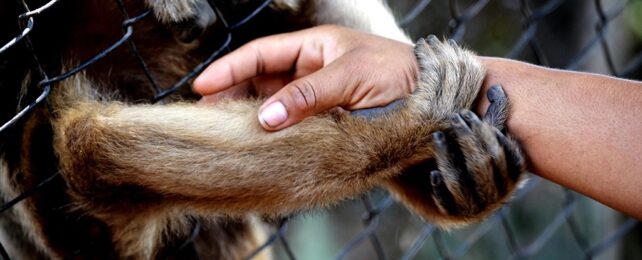We all had to make adjustments as the coronavirus pandemic unfolded – even zoo animals who were suddenly not seeing crowds of visitors pass by every single day.
In a study published last year, researchers discovered how primates reacted to that shift, looking at the behavior of bonobos, chimpanzees, western lowland gorillas, and olive baboons, and finding that the animals changed their habits in a variety of ways, including the amount of time they spent resting and eating.
Visitor interactions are thought to be crucial to the welfare of zoo animals. Yet these interactions have the potential to be either positive or negative. So the researchers were keen to see the difference when the crowds weren't there.
"Primates are some of the most cognitively advanced species in zoos and their interactions with visitors are complex," zoo animal welfare scientist Samantha Ward from Nottingham Trent University in the UK explained in 2022.
"A limitation to understanding how visitors can affect behavior of animals in zoos and parks is that they rarely close to the public for prolonged periods, so this provided us with a unique opportunity."
Observations were recorded at Twycross Zoo and Knowsley Safari in the UK, both before and after visitors returned.
Over several months and multiple open and closure periods, there were noticeable changes in primate behavior, which varied depending on the animal.
As visitors began to return to the zoo, the bonobos and gorillas spent less time alone, while the gorillas also spent less time resting. Chimpanzees, meanwhile, were eating more and engaging with their enclosures more when zoos reopened.
The olive baboons in the safari park were seen to engage in less sexual and dominance behavior when the visitors came back. They also tended to approach visitor cars more often, compared with the ranger vehicles they saw when the park was closed.
Whether or not these changes were positive is more difficult to say.
The researchers suggest that the returning visitors seemed to stimulate the chimpanzees and baboons, while gorillas and bonobos spending less time alone could also be viewed as positive.
At the same time, it could be argued that gorillas – naturally more sedentary animals – were disrupted by the crowds in that they spent less time resting.
That the gorillas changed the parts of their enclosures they spent the most time in when visitors came back suggests that the animals can to some extent manage this disruption.
"Behavioral changes and changes in enclosure use in the presence of visitors highlights the adaptability of zoo species to their environments," said zoo animal welfare researcher Ellen Williams from Harper Adams University in the UK.
"Provision of environments which enable animals to actively adapt in this manner is really important for their welfare."
The team also observed that there was a visitor number threshold when it came to olive baboons, beyond which the animals stopped becoming increasingly active and stimulated by the passing cars in the safari park.
This is all valuable data for animal welfare researchers, who know that visitors can have all kinds of effects on wildlife – from adding feelings of companionship and safety, to being sources of annoyance or even threats. This needs to be factored into how zoos and parks are run and designed.
While there might not be any more lockdowns in the foreseeable future (hopefully), the research team wants to continue the work of studying how visitor numbers affect animal behavior, including collecting data involving more animals and across a longer time scale.
"Future work could involve looking at the impact on a wider range of species in both zoos and safari parks as well as differences among individual animals," said Williams.
The research was published in Animals.
An earlier version of this article was published in September 2022.
